Sustainable Method of Power Generation and Waste Treatment using Integrated Biomass and Solar Energy
VerifiedAdded on 2022/12/27
|9
|2277
|53
AI Summary
This study focuses on the sustainable method of power generation and waste treatment using integrated biomass and solar energy. It discusses the importance of the topic, motivation behind the study, background about the system, main aim and specific objectives of the system. The study also provides a literature review on biomass as a renewable energy source and its contribution to the environment.
Contribute Materials
Your contribution can guide someone’s learning journey. Share your
documents today.
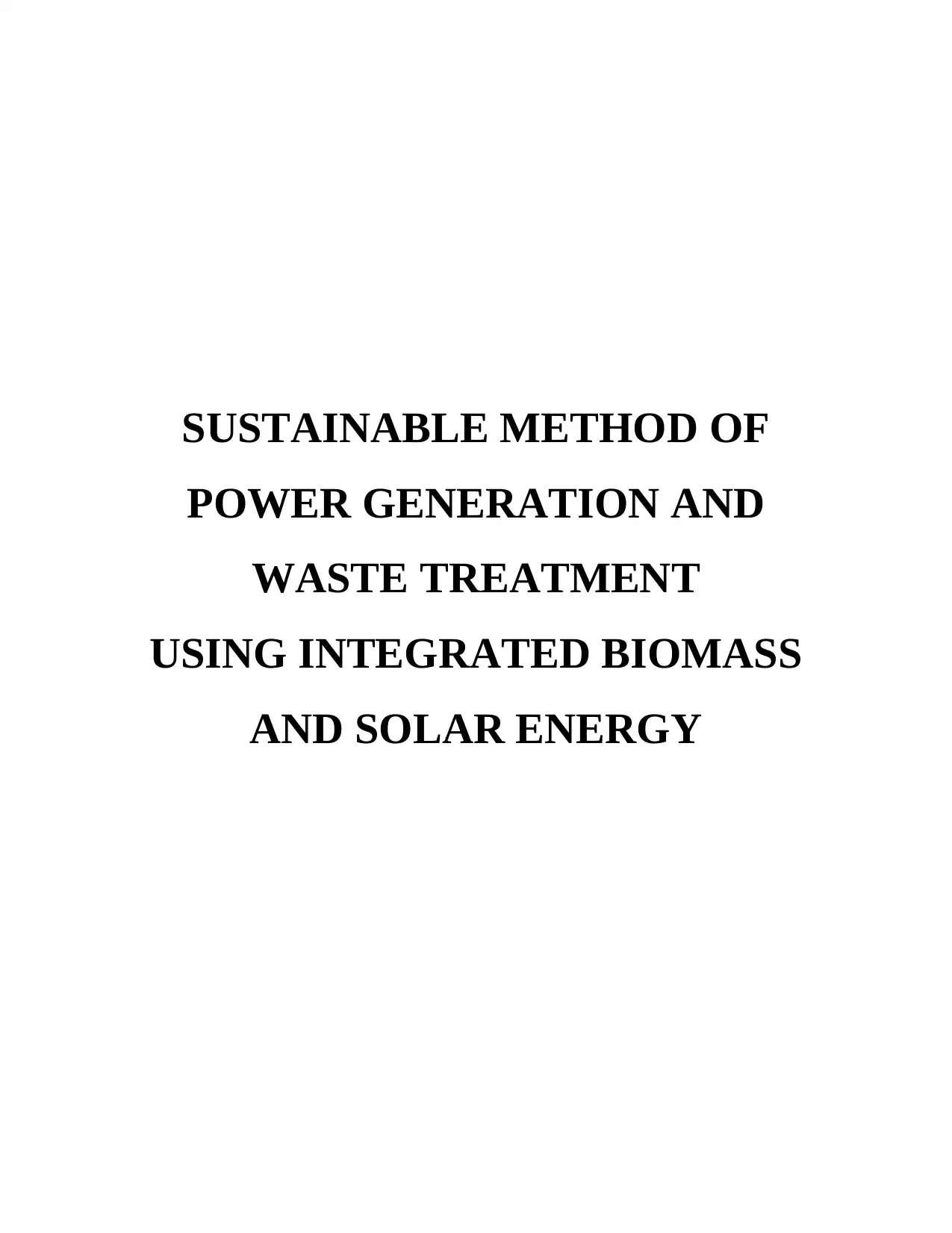
SUSTAINABLE METHOD OF
POWER GENERATION AND
WASTE TREATMENT
USING INTEGRATED BIOMASS
AND SOLAR ENERGY
POWER GENERATION AND
WASTE TREATMENT
USING INTEGRATED BIOMASS
AND SOLAR ENERGY
Secure Best Marks with AI Grader
Need help grading? Try our AI Grader for instant feedback on your assignments.
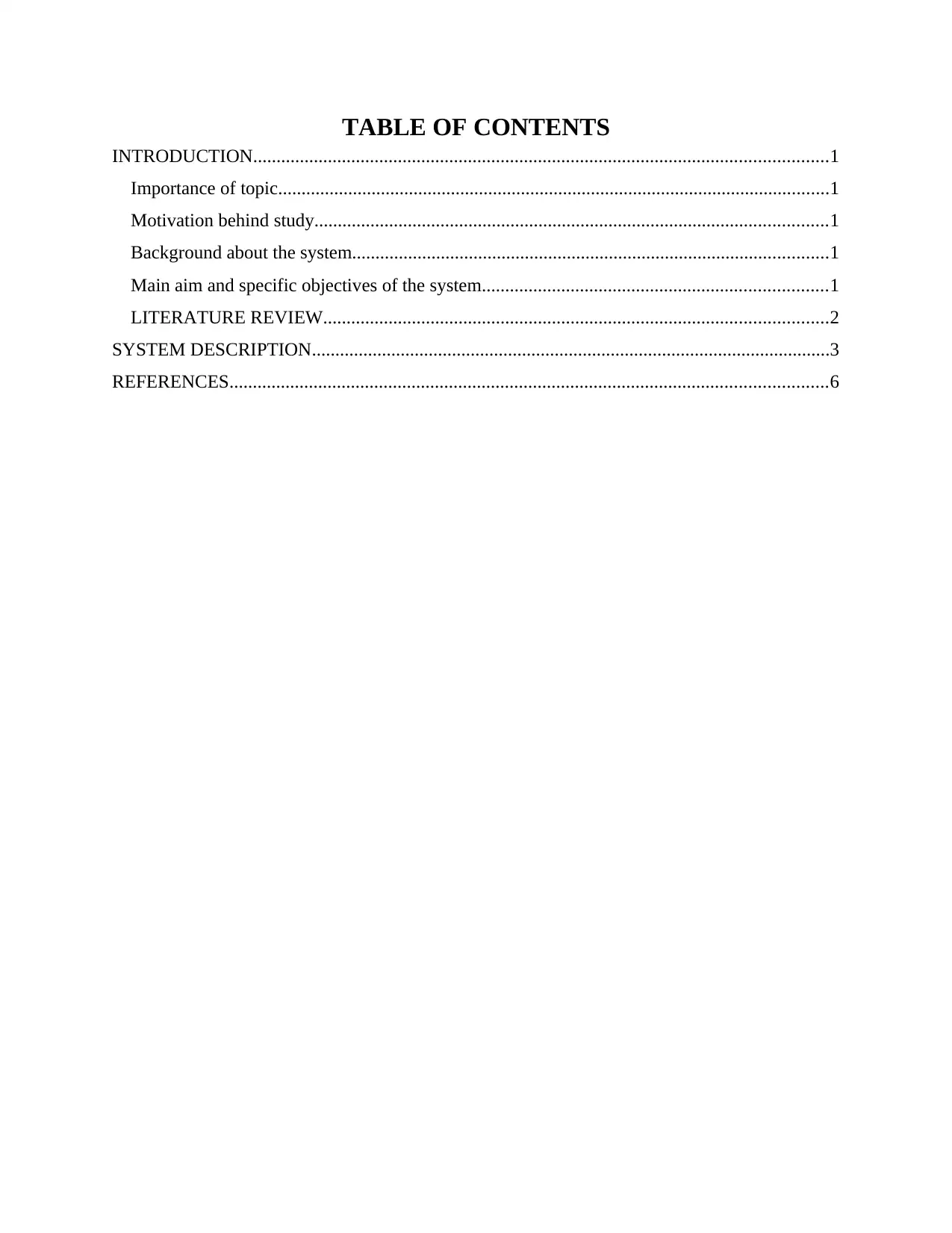
TABLE OF CONTENTS
INTRODUCTION...........................................................................................................................1
Importance of topic......................................................................................................................1
Motivation behind study..............................................................................................................1
Background about the system......................................................................................................1
Main aim and specific objectives of the system..........................................................................1
LITERATURE REVIEW............................................................................................................2
SYSTEM DESCRIPTION...............................................................................................................3
REFERENCES................................................................................................................................6
INTRODUCTION...........................................................................................................................1
Importance of topic......................................................................................................................1
Motivation behind study..............................................................................................................1
Background about the system......................................................................................................1
Main aim and specific objectives of the system..........................................................................1
LITERATURE REVIEW............................................................................................................2
SYSTEM DESCRIPTION...............................................................................................................3
REFERENCES................................................................................................................................6
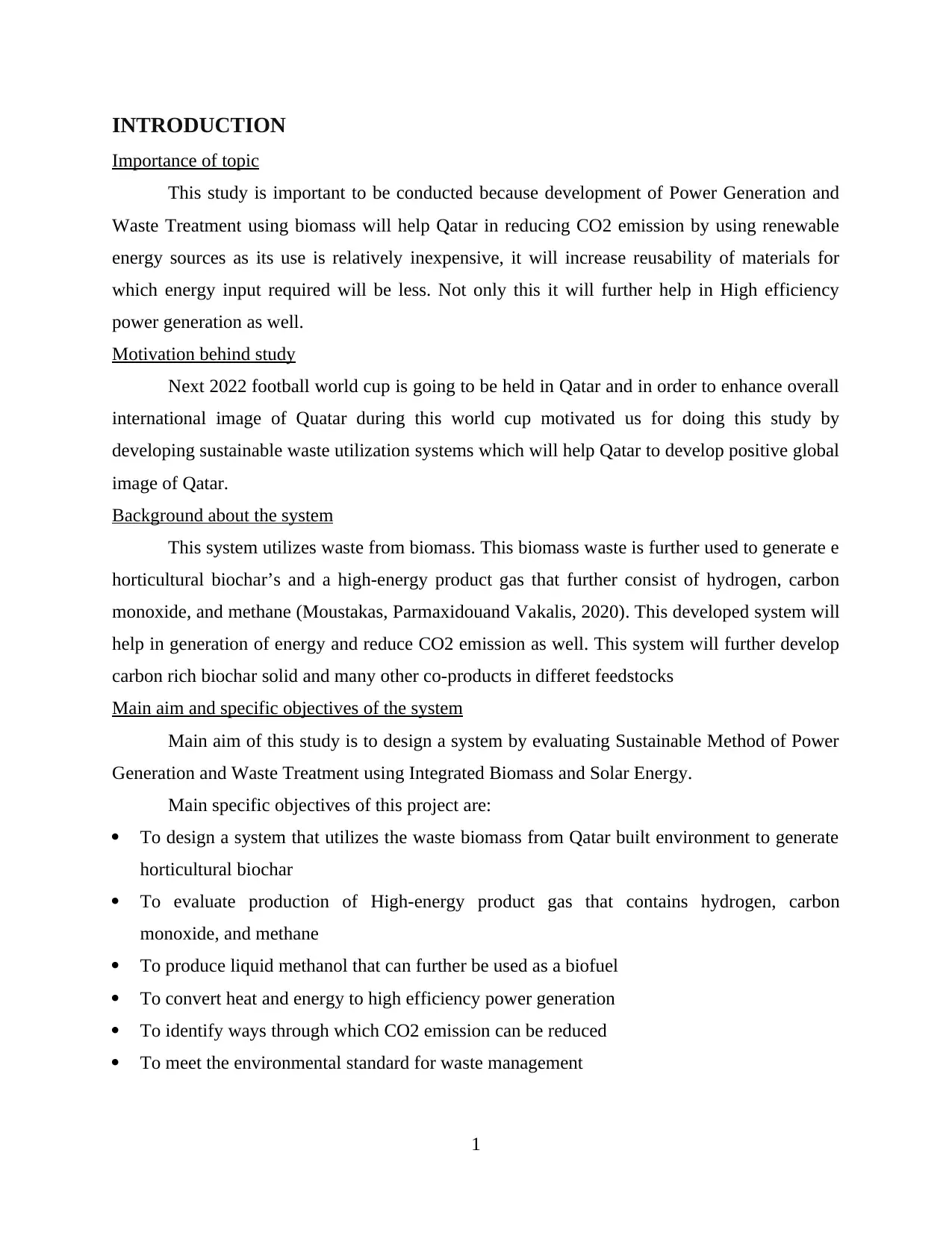
INTRODUCTION
Importance of topic
This study is important to be conducted because development of Power Generation and
Waste Treatment using biomass will help Qatar in reducing CO2 emission by using renewable
energy sources as its use is relatively inexpensive, it will increase reusability of materials for
which energy input required will be less. Not only this it will further help in High efficiency
power generation as well.
Motivation behind study
Next 2022 football world cup is going to be held in Qatar and in order to enhance overall
international image of Quatar during this world cup motivated us for doing this study by
developing sustainable waste utilization systems which will help Qatar to develop positive global
image of Qatar.
Background about the system
This system utilizes waste from biomass. This biomass waste is further used to generate e
horticultural biochar’s and a high-energy product gas that further consist of hydrogen, carbon
monoxide, and methane (Moustakas, Parmaxidouand Vakalis, 2020). This developed system will
help in generation of energy and reduce CO2 emission as well. This system will further develop
carbon rich biochar solid and many other co-products in differet feedstocks
Main aim and specific objectives of the system
Main aim of this study is to design a system by evaluating Sustainable Method of Power
Generation and Waste Treatment using Integrated Biomass and Solar Energy.
Main specific objectives of this project are:
To design a system that utilizes the waste biomass from Qatar built environment to generate
horticultural biochar
To evaluate production of High-energy product gas that contains hydrogen, carbon
monoxide, and methane
To produce liquid methanol that can further be used as a biofuel
To convert heat and energy to high efficiency power generation
To identify ways through which CO2 emission can be reduced
To meet the environmental standard for waste management
1
Importance of topic
This study is important to be conducted because development of Power Generation and
Waste Treatment using biomass will help Qatar in reducing CO2 emission by using renewable
energy sources as its use is relatively inexpensive, it will increase reusability of materials for
which energy input required will be less. Not only this it will further help in High efficiency
power generation as well.
Motivation behind study
Next 2022 football world cup is going to be held in Qatar and in order to enhance overall
international image of Quatar during this world cup motivated us for doing this study by
developing sustainable waste utilization systems which will help Qatar to develop positive global
image of Qatar.
Background about the system
This system utilizes waste from biomass. This biomass waste is further used to generate e
horticultural biochar’s and a high-energy product gas that further consist of hydrogen, carbon
monoxide, and methane (Moustakas, Parmaxidouand Vakalis, 2020). This developed system will
help in generation of energy and reduce CO2 emission as well. This system will further develop
carbon rich biochar solid and many other co-products in differet feedstocks
Main aim and specific objectives of the system
Main aim of this study is to design a system by evaluating Sustainable Method of Power
Generation and Waste Treatment using Integrated Biomass and Solar Energy.
Main specific objectives of this project are:
To design a system that utilizes the waste biomass from Qatar built environment to generate
horticultural biochar
To evaluate production of High-energy product gas that contains hydrogen, carbon
monoxide, and methane
To produce liquid methanol that can further be used as a biofuel
To convert heat and energy to high efficiency power generation
To identify ways through which CO2 emission can be reduced
To meet the environmental standard for waste management
1
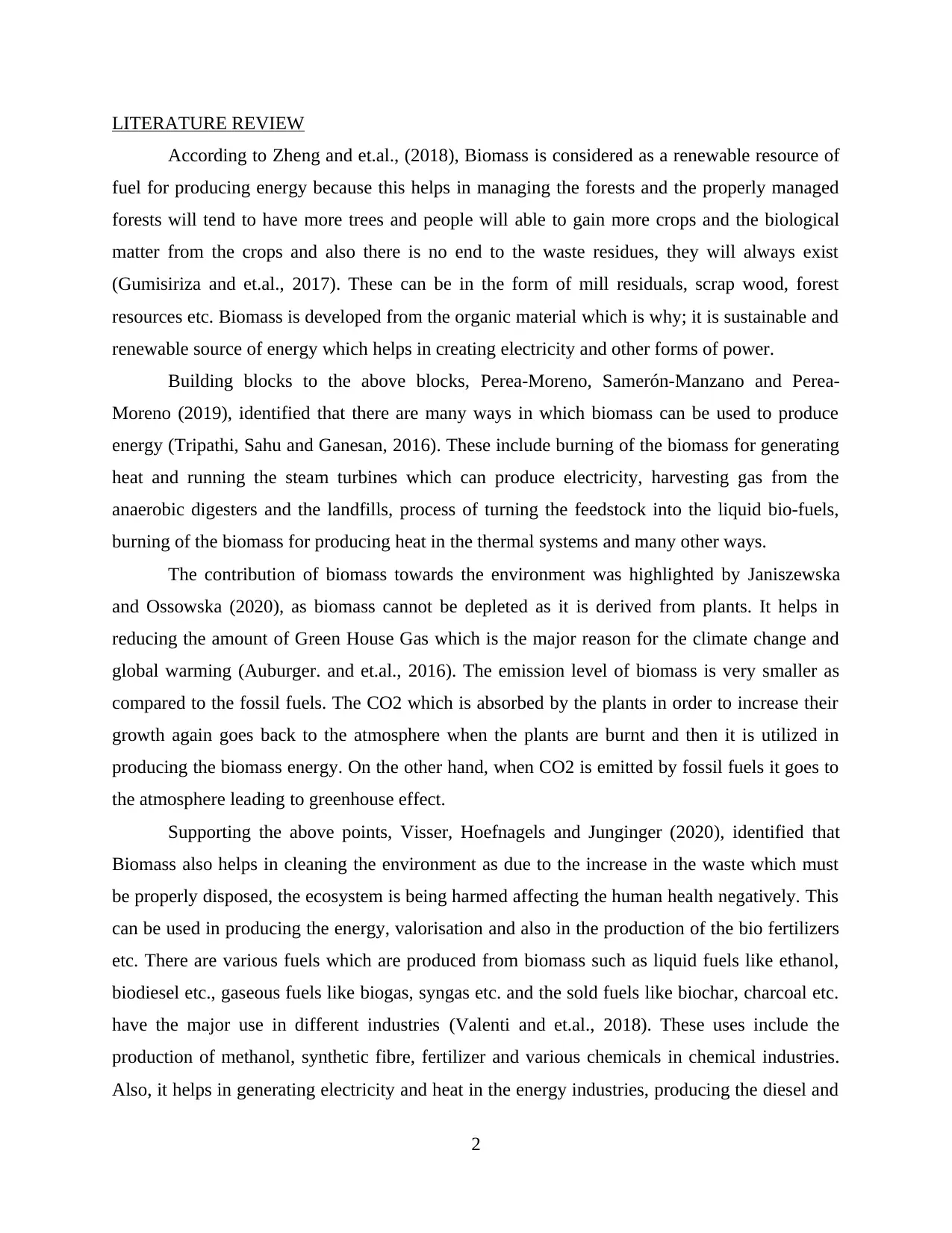
LITERATURE REVIEW
According to Zheng and et.al., (2018), Biomass is considered as a renewable resource of
fuel for producing energy because this helps in managing the forests and the properly managed
forests will tend to have more trees and people will able to gain more crops and the biological
matter from the crops and also there is no end to the waste residues, they will always exist
(Gumisiriza and et.al., 2017). These can be in the form of mill residuals, scrap wood, forest
resources etc. Biomass is developed from the organic material which is why; it is sustainable and
renewable source of energy which helps in creating electricity and other forms of power.
Building blocks to the above blocks, Perea-Moreno, Samerón-Manzano and Perea-
Moreno (2019), identified that there are many ways in which biomass can be used to produce
energy (Tripathi, Sahu and Ganesan, 2016). These include burning of the biomass for generating
heat and running the steam turbines which can produce electricity, harvesting gas from the
anaerobic digesters and the landfills, process of turning the feedstock into the liquid bio-fuels,
burning of the biomass for producing heat in the thermal systems and many other ways.
The contribution of biomass towards the environment was highlighted by Janiszewska
and Ossowska (2020), as biomass cannot be depleted as it is derived from plants. It helps in
reducing the amount of Green House Gas which is the major reason for the climate change and
global warming (Auburger. and et.al., 2016). The emission level of biomass is very smaller as
compared to the fossil fuels. The CO2 which is absorbed by the plants in order to increase their
growth again goes back to the atmosphere when the plants are burnt and then it is utilized in
producing the biomass energy. On the other hand, when CO2 is emitted by fossil fuels it goes to
the atmosphere leading to greenhouse effect.
Supporting the above points, Visser, Hoefnagels and Junginger (2020), identified that
Biomass also helps in cleaning the environment as due to the increase in the waste which must
be properly disposed, the ecosystem is being harmed affecting the human health negatively. This
can be used in producing the energy, valorisation and also in the production of the bio fertilizers
etc. There are various fuels which are produced from biomass such as liquid fuels like ethanol,
biodiesel etc., gaseous fuels like biogas, syngas etc. and the sold fuels like biochar, charcoal etc.
have the major use in different industries (Valenti and et.al., 2018). These uses include the
production of methanol, synthetic fibre, fertilizer and various chemicals in chemical industries.
Also, it helps in generating electricity and heat in the energy industries, producing the diesel and
2
According to Zheng and et.al., (2018), Biomass is considered as a renewable resource of
fuel for producing energy because this helps in managing the forests and the properly managed
forests will tend to have more trees and people will able to gain more crops and the biological
matter from the crops and also there is no end to the waste residues, they will always exist
(Gumisiriza and et.al., 2017). These can be in the form of mill residuals, scrap wood, forest
resources etc. Biomass is developed from the organic material which is why; it is sustainable and
renewable source of energy which helps in creating electricity and other forms of power.
Building blocks to the above blocks, Perea-Moreno, Samerón-Manzano and Perea-
Moreno (2019), identified that there are many ways in which biomass can be used to produce
energy (Tripathi, Sahu and Ganesan, 2016). These include burning of the biomass for generating
heat and running the steam turbines which can produce electricity, harvesting gas from the
anaerobic digesters and the landfills, process of turning the feedstock into the liquid bio-fuels,
burning of the biomass for producing heat in the thermal systems and many other ways.
The contribution of biomass towards the environment was highlighted by Janiszewska
and Ossowska (2020), as biomass cannot be depleted as it is derived from plants. It helps in
reducing the amount of Green House Gas which is the major reason for the climate change and
global warming (Auburger. and et.al., 2016). The emission level of biomass is very smaller as
compared to the fossil fuels. The CO2 which is absorbed by the plants in order to increase their
growth again goes back to the atmosphere when the plants are burnt and then it is utilized in
producing the biomass energy. On the other hand, when CO2 is emitted by fossil fuels it goes to
the atmosphere leading to greenhouse effect.
Supporting the above points, Visser, Hoefnagels and Junginger (2020), identified that
Biomass also helps in cleaning the environment as due to the increase in the waste which must
be properly disposed, the ecosystem is being harmed affecting the human health negatively. This
can be used in producing the energy, valorisation and also in the production of the bio fertilizers
etc. There are various fuels which are produced from biomass such as liquid fuels like ethanol,
biodiesel etc., gaseous fuels like biogas, syngas etc. and the sold fuels like biochar, charcoal etc.
have the major use in different industries (Valenti and et.al., 2018). These uses include the
production of methanol, synthetic fibre, fertilizer and various chemicals in chemical industries.
Also, it helps in generating electricity and heat in the energy industries, producing the diesel and
2
Secure Best Marks with AI Grader
Need help grading? Try our AI Grader for instant feedback on your assignments.
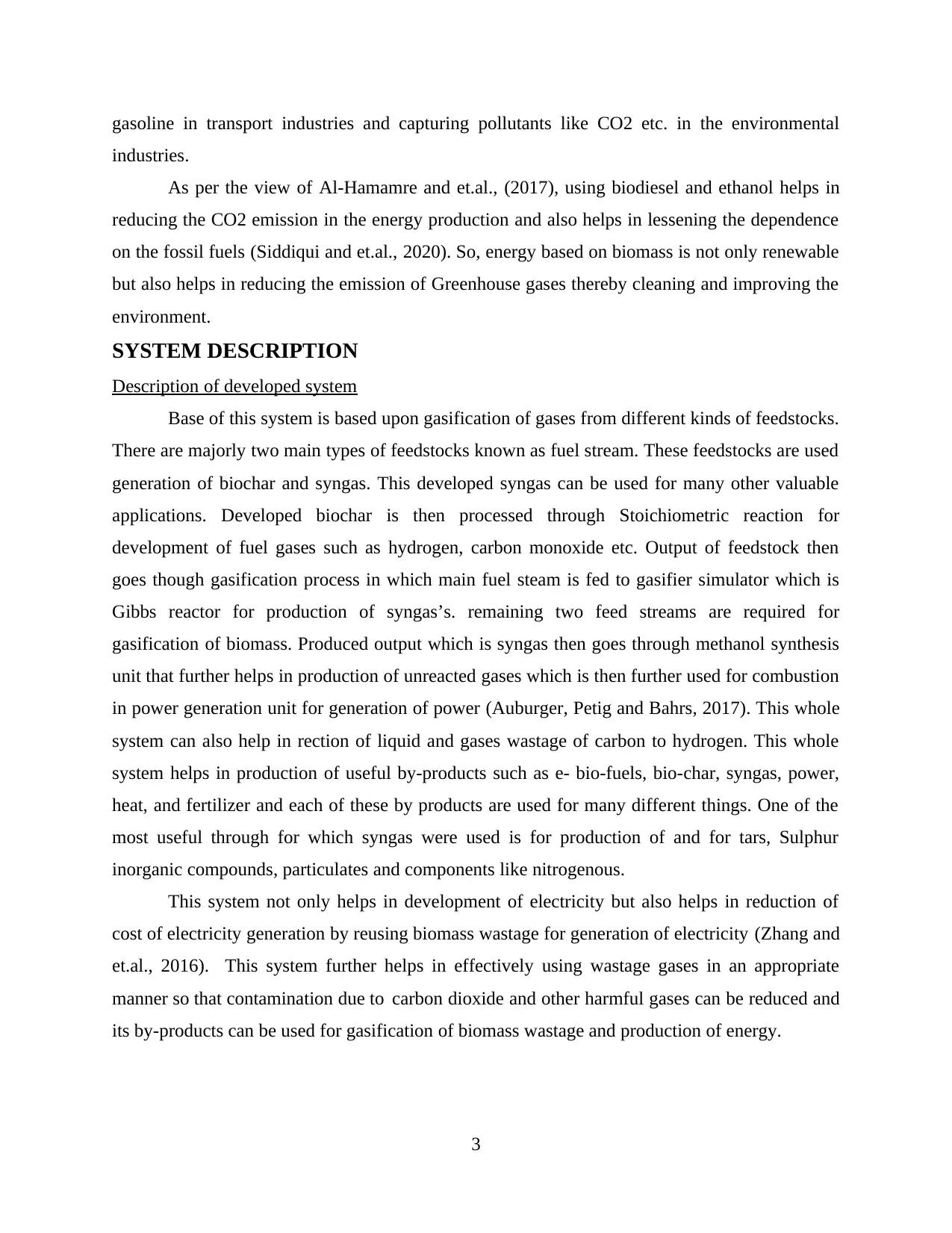
gasoline in transport industries and capturing pollutants like CO2 etc. in the environmental
industries.
As per the view of Al-Hamamre and et.al., (2017), using biodiesel and ethanol helps in
reducing the CO2 emission in the energy production and also helps in lessening the dependence
on the fossil fuels (Siddiqui and et.al., 2020). So, energy based on biomass is not only renewable
but also helps in reducing the emission of Greenhouse gases thereby cleaning and improving the
environment.
SYSTEM DESCRIPTION
Description of developed system
Base of this system is based upon gasification of gases from different kinds of feedstocks.
There are majorly two main types of feedstocks known as fuel stream. These feedstocks are used
generation of biochar and syngas. This developed syngas can be used for many other valuable
applications. Developed biochar is then processed through Stoichiometric reaction for
development of fuel gases such as hydrogen, carbon monoxide etc. Output of feedstock then
goes though gasification process in which main fuel steam is fed to gasifier simulator which is
Gibbs reactor for production of syngas’s. remaining two feed streams are required for
gasification of biomass. Produced output which is syngas then goes through methanol synthesis
unit that further helps in production of unreacted gases which is then further used for combustion
in power generation unit for generation of power (Auburger, Petig and Bahrs, 2017). This whole
system can also help in rection of liquid and gases wastage of carbon to hydrogen. This whole
system helps in production of useful by-products such as e- bio-fuels, bio-char, syngas, power,
heat, and fertilizer and each of these by products are used for many different things. One of the
most useful through for which syngas were used is for production of and for tars, Sulphur
inorganic compounds, particulates and components like nitrogenous.
This system not only helps in development of electricity but also helps in reduction of
cost of electricity generation by reusing biomass wastage for generation of electricity (Zhang and
et.al., 2016). This system further helps in effectively using wastage gases in an appropriate
manner so that contamination due to carbon dioxide and other harmful gases can be reduced and
its by-products can be used for gasification of biomass wastage and production of energy.
3
industries.
As per the view of Al-Hamamre and et.al., (2017), using biodiesel and ethanol helps in
reducing the CO2 emission in the energy production and also helps in lessening the dependence
on the fossil fuels (Siddiqui and et.al., 2020). So, energy based on biomass is not only renewable
but also helps in reducing the emission of Greenhouse gases thereby cleaning and improving the
environment.
SYSTEM DESCRIPTION
Description of developed system
Base of this system is based upon gasification of gases from different kinds of feedstocks.
There are majorly two main types of feedstocks known as fuel stream. These feedstocks are used
generation of biochar and syngas. This developed syngas can be used for many other valuable
applications. Developed biochar is then processed through Stoichiometric reaction for
development of fuel gases such as hydrogen, carbon monoxide etc. Output of feedstock then
goes though gasification process in which main fuel steam is fed to gasifier simulator which is
Gibbs reactor for production of syngas’s. remaining two feed streams are required for
gasification of biomass. Produced output which is syngas then goes through methanol synthesis
unit that further helps in production of unreacted gases which is then further used for combustion
in power generation unit for generation of power (Auburger, Petig and Bahrs, 2017). This whole
system can also help in rection of liquid and gases wastage of carbon to hydrogen. This whole
system helps in production of useful by-products such as e- bio-fuels, bio-char, syngas, power,
heat, and fertilizer and each of these by products are used for many different things. One of the
most useful through for which syngas were used is for production of and for tars, Sulphur
inorganic compounds, particulates and components like nitrogenous.
This system not only helps in development of electricity but also helps in reduction of
cost of electricity generation by reusing biomass wastage for generation of electricity (Zhang and
et.al., 2016). This system further helps in effectively using wastage gases in an appropriate
manner so that contamination due to carbon dioxide and other harmful gases can be reduced and
its by-products can be used for gasification of biomass wastage and production of energy.
3
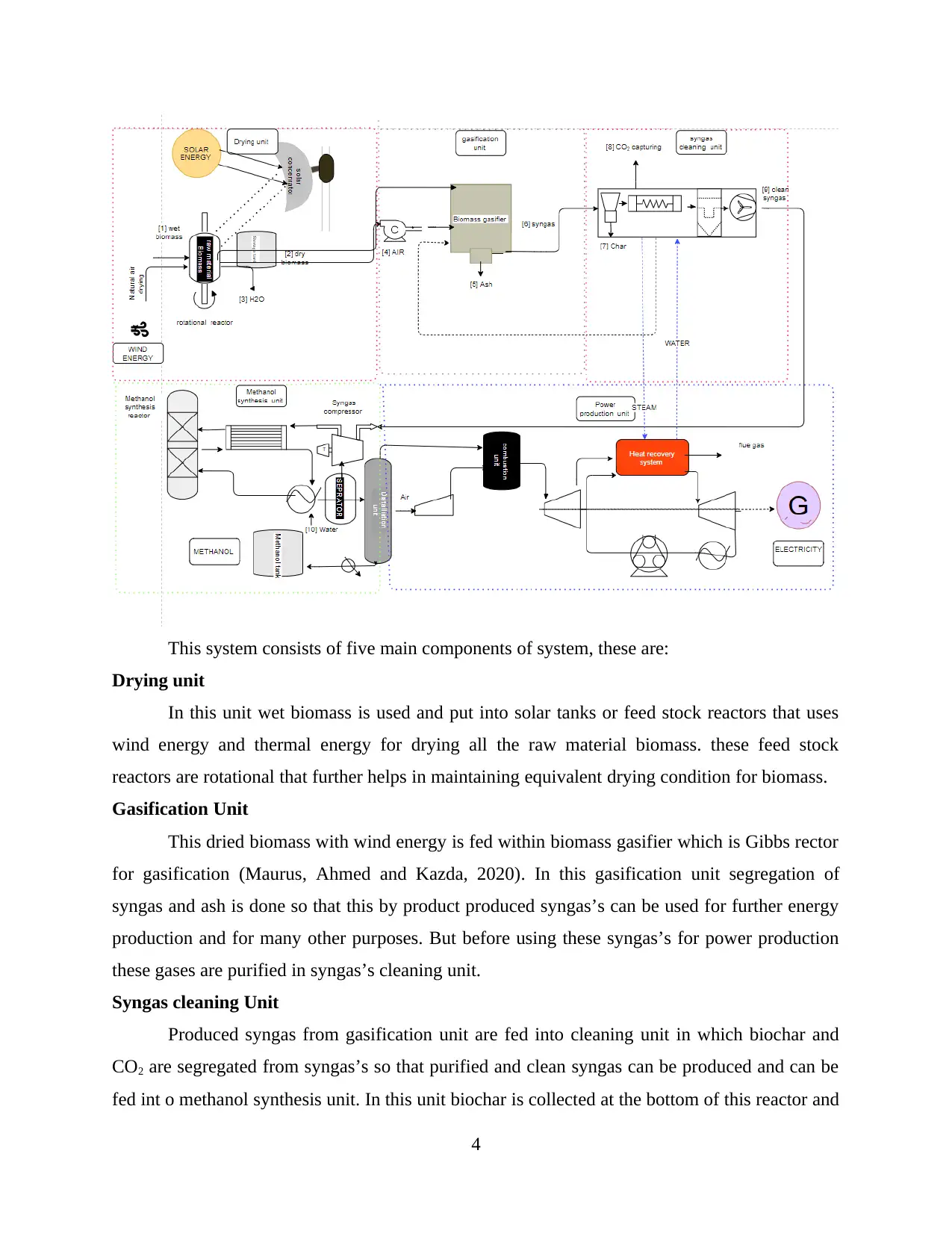
This system consists of five main components of system, these are:
Drying unit
In this unit wet biomass is used and put into solar tanks or feed stock reactors that uses
wind energy and thermal energy for drying all the raw material biomass. these feed stock
reactors are rotational that further helps in maintaining equivalent drying condition for biomass.
Gasification Unit
This dried biomass with wind energy is fed within biomass gasifier which is Gibbs rector
for gasification (Maurus, Ahmed and Kazda, 2020). In this gasification unit segregation of
syngas and ash is done so that this by product produced syngas’s can be used for further energy
production and for many other purposes. But before using these syngas’s for power production
these gases are purified in syngas’s cleaning unit.
Syngas cleaning Unit
Produced syngas from gasification unit are fed into cleaning unit in which biochar and
CO2 are segregated from syngas’s so that purified and clean syngas can be produced and can be
fed int o methanol synthesis unit. In this unit biochar is collected at the bottom of this reactor and
4
Drying unit
In this unit wet biomass is used and put into solar tanks or feed stock reactors that uses
wind energy and thermal energy for drying all the raw material biomass. these feed stock
reactors are rotational that further helps in maintaining equivalent drying condition for biomass.
Gasification Unit
This dried biomass with wind energy is fed within biomass gasifier which is Gibbs rector
for gasification (Maurus, Ahmed and Kazda, 2020). In this gasification unit segregation of
syngas and ash is done so that this by product produced syngas’s can be used for further energy
production and for many other purposes. But before using these syngas’s for power production
these gases are purified in syngas’s cleaning unit.
Syngas cleaning Unit
Produced syngas from gasification unit are fed into cleaning unit in which biochar and
CO2 are segregated from syngas’s so that purified and clean syngas can be produced and can be
fed int o methanol synthesis unit. In this unit biochar is collected at the bottom of this reactor and
4
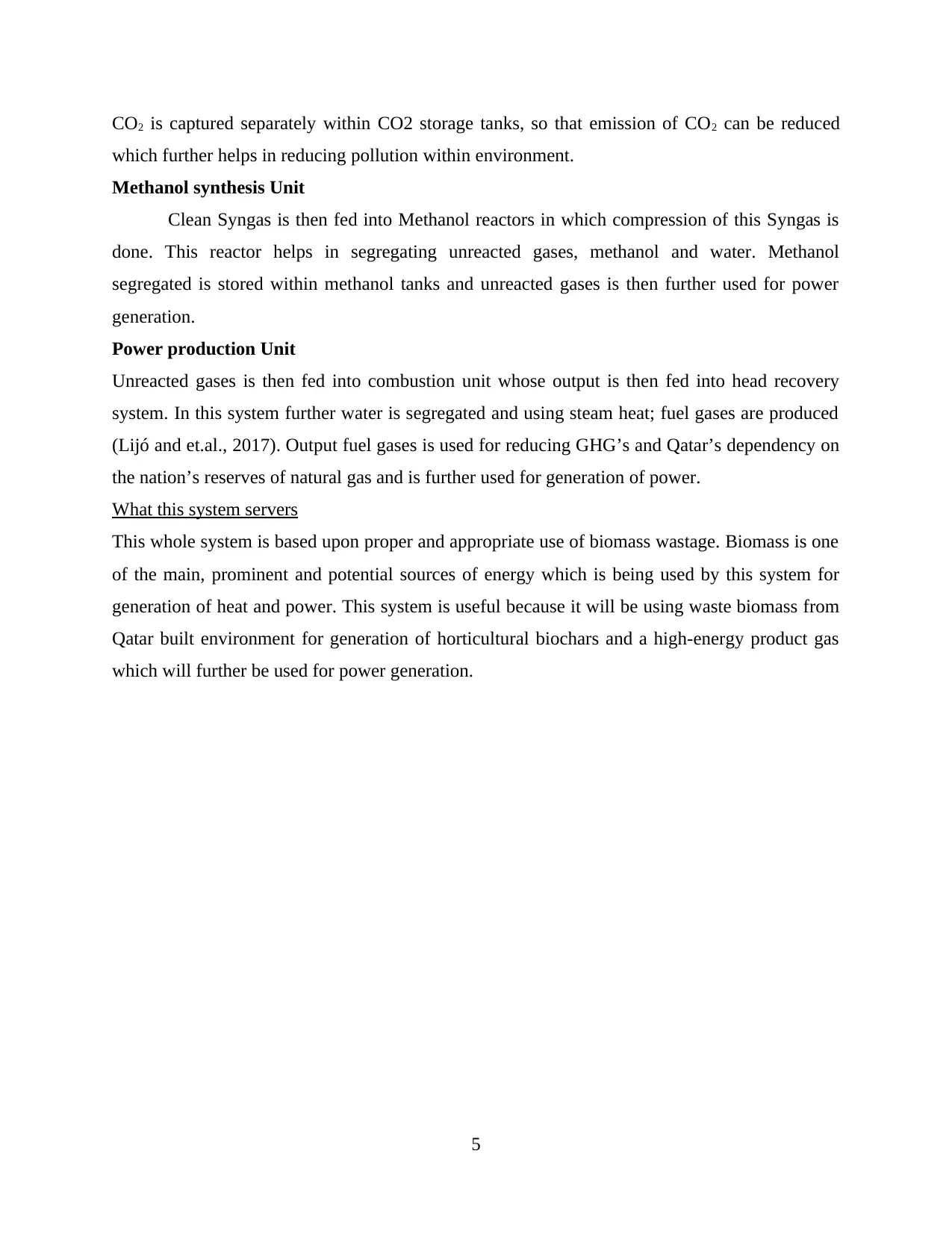
CO2 is captured separately within CO2 storage tanks, so that emission of CO2 can be reduced
which further helps in reducing pollution within environment.
Methanol synthesis Unit
Clean Syngas is then fed into Methanol reactors in which compression of this Syngas is
done. This reactor helps in segregating unreacted gases, methanol and water. Methanol
segregated is stored within methanol tanks and unreacted gases is then further used for power
generation.
Power production Unit
Unreacted gases is then fed into combustion unit whose output is then fed into head recovery
system. In this system further water is segregated and using steam heat; fuel gases are produced
(Lijó and et.al., 2017). Output fuel gases is used for reducing GHG’s and Qatar’s dependency on
the nation’s reserves of natural gas and is further used for generation of power.
What this system servers
This whole system is based upon proper and appropriate use of biomass wastage. Biomass is one
of the main, prominent and potential sources of energy which is being used by this system for
generation of heat and power. This system is useful because it will be using waste biomass from
Qatar built environment for generation of horticultural biochars and a high-energy product gas
which will further be used for power generation.
5
which further helps in reducing pollution within environment.
Methanol synthesis Unit
Clean Syngas is then fed into Methanol reactors in which compression of this Syngas is
done. This reactor helps in segregating unreacted gases, methanol and water. Methanol
segregated is stored within methanol tanks and unreacted gases is then further used for power
generation.
Power production Unit
Unreacted gases is then fed into combustion unit whose output is then fed into head recovery
system. In this system further water is segregated and using steam heat; fuel gases are produced
(Lijó and et.al., 2017). Output fuel gases is used for reducing GHG’s and Qatar’s dependency on
the nation’s reserves of natural gas and is further used for generation of power.
What this system servers
This whole system is based upon proper and appropriate use of biomass wastage. Biomass is one
of the main, prominent and potential sources of energy which is being used by this system for
generation of heat and power. This system is useful because it will be using waste biomass from
Qatar built environment for generation of horticultural biochars and a high-energy product gas
which will further be used for power generation.
5
Paraphrase This Document
Need a fresh take? Get an instant paraphrase of this document with our AI Paraphraser
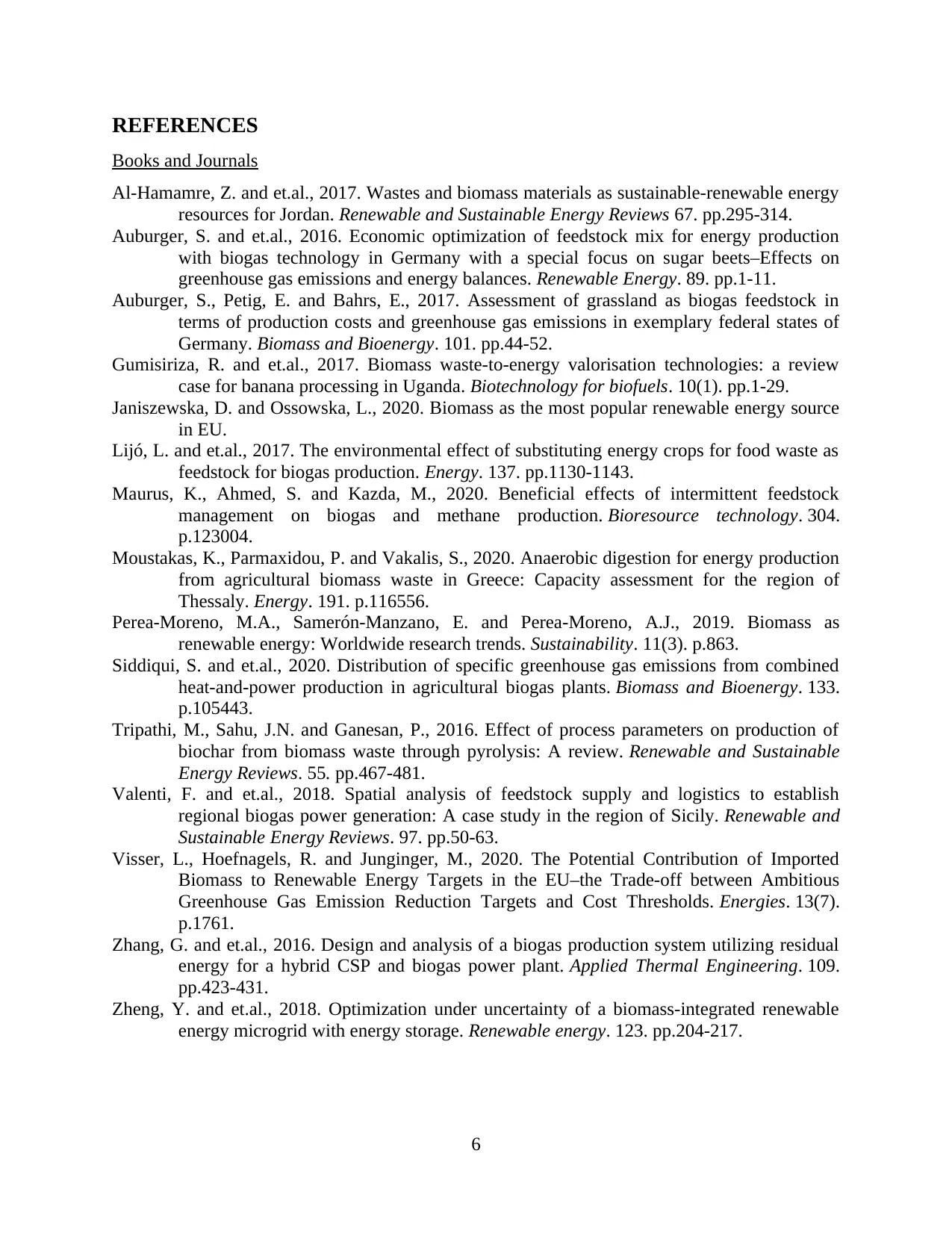
REFERENCES
Books and Journals
Al-Hamamre, Z. and et.al., 2017. Wastes and biomass materials as sustainable-renewable energy
resources for Jordan. Renewable and Sustainable Energy Reviews 67. pp.295-314.
Auburger, S. and et.al., 2016. Economic optimization of feedstock mix for energy production
with biogas technology in Germany with a special focus on sugar beets–Effects on
greenhouse gas emissions and energy balances. Renewable Energy. 89. pp.1-11.
Auburger, S., Petig, E. and Bahrs, E., 2017. Assessment of grassland as biogas feedstock in
terms of production costs and greenhouse gas emissions in exemplary federal states of
Germany. Biomass and Bioenergy. 101. pp.44-52.
Gumisiriza, R. and et.al., 2017. Biomass waste-to-energy valorisation technologies: a review
case for banana processing in Uganda. Biotechnology for biofuels. 10(1). pp.1-29.
Janiszewska, D. and Ossowska, L., 2020. Biomass as the most popular renewable energy source
in EU.
Lijó, L. and et.al., 2017. The environmental effect of substituting energy crops for food waste as
feedstock for biogas production. Energy. 137. pp.1130-1143.
Maurus, K., Ahmed, S. and Kazda, M., 2020. Beneficial effects of intermittent feedstock
management on biogas and methane production. Bioresource technology. 304.
p.123004.
Moustakas, K., Parmaxidou, P. and Vakalis, S., 2020. Anaerobic digestion for energy production
from agricultural biomass waste in Greece: Capacity assessment for the region of
Thessaly. Energy. 191. p.116556.
Perea-Moreno, M.A., Samerón-Manzano, E. and Perea-Moreno, A.J., 2019. Biomass as
renewable energy: Worldwide research trends. Sustainability. 11(3). p.863.
Siddiqui, S. and et.al., 2020. Distribution of specific greenhouse gas emissions from combined
heat-and-power production in agricultural biogas plants. Biomass and Bioenergy. 133.
p.105443.
Tripathi, M., Sahu, J.N. and Ganesan, P., 2016. Effect of process parameters on production of
biochar from biomass waste through pyrolysis: A review. Renewable and Sustainable
Energy Reviews. 55. pp.467-481.
Valenti, F. and et.al., 2018. Spatial analysis of feedstock supply and logistics to establish
regional biogas power generation: A case study in the region of Sicily. Renewable and
Sustainable Energy Reviews. 97. pp.50-63.
Visser, L., Hoefnagels, R. and Junginger, M., 2020. The Potential Contribution of Imported
Biomass to Renewable Energy Targets in the EU–the Trade-off between Ambitious
Greenhouse Gas Emission Reduction Targets and Cost Thresholds. Energies. 13(7).
p.1761.
Zhang, G. and et.al., 2016. Design and analysis of a biogas production system utilizing residual
energy for a hybrid CSP and biogas power plant. Applied Thermal Engineering. 109.
pp.423-431.
Zheng, Y. and et.al., 2018. Optimization under uncertainty of a biomass-integrated renewable
energy microgrid with energy storage. Renewable energy. 123. pp.204-217.
6
Books and Journals
Al-Hamamre, Z. and et.al., 2017. Wastes and biomass materials as sustainable-renewable energy
resources for Jordan. Renewable and Sustainable Energy Reviews 67. pp.295-314.
Auburger, S. and et.al., 2016. Economic optimization of feedstock mix for energy production
with biogas technology in Germany with a special focus on sugar beets–Effects on
greenhouse gas emissions and energy balances. Renewable Energy. 89. pp.1-11.
Auburger, S., Petig, E. and Bahrs, E., 2017. Assessment of grassland as biogas feedstock in
terms of production costs and greenhouse gas emissions in exemplary federal states of
Germany. Biomass and Bioenergy. 101. pp.44-52.
Gumisiriza, R. and et.al., 2017. Biomass waste-to-energy valorisation technologies: a review
case for banana processing in Uganda. Biotechnology for biofuels. 10(1). pp.1-29.
Janiszewska, D. and Ossowska, L., 2020. Biomass as the most popular renewable energy source
in EU.
Lijó, L. and et.al., 2017. The environmental effect of substituting energy crops for food waste as
feedstock for biogas production. Energy. 137. pp.1130-1143.
Maurus, K., Ahmed, S. and Kazda, M., 2020. Beneficial effects of intermittent feedstock
management on biogas and methane production. Bioresource technology. 304.
p.123004.
Moustakas, K., Parmaxidou, P. and Vakalis, S., 2020. Anaerobic digestion for energy production
from agricultural biomass waste in Greece: Capacity assessment for the region of
Thessaly. Energy. 191. p.116556.
Perea-Moreno, M.A., Samerón-Manzano, E. and Perea-Moreno, A.J., 2019. Biomass as
renewable energy: Worldwide research trends. Sustainability. 11(3). p.863.
Siddiqui, S. and et.al., 2020. Distribution of specific greenhouse gas emissions from combined
heat-and-power production in agricultural biogas plants. Biomass and Bioenergy. 133.
p.105443.
Tripathi, M., Sahu, J.N. and Ganesan, P., 2016. Effect of process parameters on production of
biochar from biomass waste through pyrolysis: A review. Renewable and Sustainable
Energy Reviews. 55. pp.467-481.
Valenti, F. and et.al., 2018. Spatial analysis of feedstock supply and logistics to establish
regional biogas power generation: A case study in the region of Sicily. Renewable and
Sustainable Energy Reviews. 97. pp.50-63.
Visser, L., Hoefnagels, R. and Junginger, M., 2020. The Potential Contribution of Imported
Biomass to Renewable Energy Targets in the EU–the Trade-off between Ambitious
Greenhouse Gas Emission Reduction Targets and Cost Thresholds. Energies. 13(7).
p.1761.
Zhang, G. and et.al., 2016. Design and analysis of a biogas production system utilizing residual
energy for a hybrid CSP and biogas power plant. Applied Thermal Engineering. 109.
pp.423-431.
Zheng, Y. and et.al., 2018. Optimization under uncertainty of a biomass-integrated renewable
energy microgrid with energy storage. Renewable energy. 123. pp.204-217.
6

7
1 out of 9
Related Documents
Your All-in-One AI-Powered Toolkit for Academic Success.
+13062052269
info@desklib.com
Available 24*7 on WhatsApp / Email
![[object Object]](/_next/static/media/star-bottom.7253800d.svg)
Unlock your academic potential
© 2024 | Zucol Services PVT LTD | All rights reserved.





